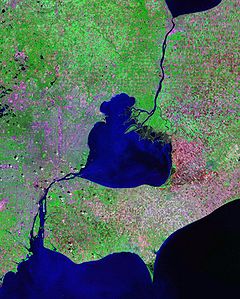Heart of the Great Lakes
Lake St. Clair provides recreational, environmental and economic benefits to residents.
Lake St. Clair, while not one of the five Great Lakes, is an important contributor in the Great Lakes’ watershed system. It’s called the heart of the Great Lakes due to its shape and importance it plays in the economic, environmental and recreational aspects for Michigan, the United States and Canada.
Lake St. Clair is the newest and smallest of the glacially-formed lakes that make up the Great Lakes watershed. It lies between Lake Huron and Lake Erie connected to these lakes by the St. Clair River to the north and the Detroit River to the south. The lake is 26 miles long and 24 miles wide with a total of 430 square miles of surface area. Compare this to Lake Ontario which is the smallest of the Great Lakes and measures 193 miles long, 53 miles wide with 7340 square miles of surface area. Lake St. Clair has an average depth of 10 feet and a maximum depth of 21 feet. Water retention time in the lake is seven to 10 days compared to Lake Superior with a retention time of 197 years.
On the northeast area of Lake St. Clair is one of the largest fresh water deltas in the world. The St. Clair River delta is called a bird’s foot delta because its formation looks like a bird’s claw. A delta forms when a river meets another water body. Sediment travels down the river to the mouth. When it meets a lake, ocean, etc., this forces the river current to slow down and the sediment in the river water is deposited at that point. The talons form the delta in Lake St. Clair. The delta is home of the Walpole Island First Nation.
 The economic, environmental and recreational benefits provided by Lake St. Clair are intertwined. Economically, 3000 freighters use the Lake St. Clair shipping channel which connects the Detroit River to the St. Clair River and the upper Great Lakes. U.S. freights alone transported 93.8 tons of cargo, primarily iron ore, limestone and coal for manufacturing, in 2011.
The economic, environmental and recreational benefits provided by Lake St. Clair are intertwined. Economically, 3000 freighters use the Lake St. Clair shipping channel which connects the Detroit River to the St. Clair River and the upper Great Lakes. U.S. freights alone transported 93.8 tons of cargo, primarily iron ore, limestone and coal for manufacturing, in 2011.
Recreationally, it provides boating and fishing activities year round. There are nearly 150,000 boats registered in the three Michigan counties adjacent to Lake St. Clair providing $260 million to local boating related activities and businesses. Lake St. Clair has one-third of the Great Lakes sport fishing catch and one-half of the Great Lakes sport fishing effort. Annually, 1.5 million fish are caught in the lake equaling $30 million. This is due, in part, to the fact that Lake St. Clair is the number one muskie lake in North America and also known as the state’s premier bass fishery.
Environmentally, Lake St. Clair provides drinking water for 4.5 to 5 million people in the United States and Canada. Over one million waterfowl use the delta area annually. The lake provides habitat for a large number of plant and animal species despite significant loss of wetlands along the shoreline.
To educate and celebrate this important resource, MSU Extension offers a variety of educational experiences both about and on the lake. The Great Lakes Education Program offers students hands-on experiences to learn about the cultural, physical, biological and chemical aspects of both Lake St. Clair and the Clinton River, one of its tributaries. For family and group oriented educational cruises, Michigan Sea Grant and MSU Extension offer Summer Discovery Cruises on Lake St. Clair and the Lower Detroit River. These cruises offer a variety of topics for every interest.



 Print
Print Email
Email



